Demonstrative AdjectivesA demonstrative adjective changes a noun or pronoun while highlighting its significance. This and that are the main demonstrative adjective used in sentences to show which of the nouns or pronouns are being referred to. 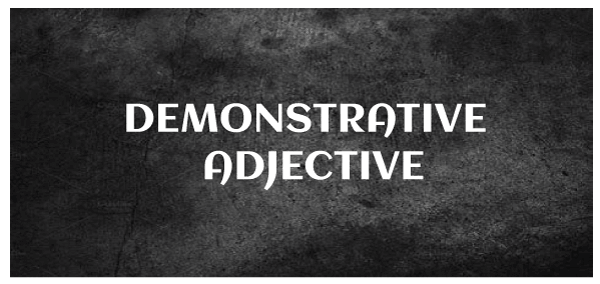
Read on to discover examples of popular demonstrative adjectives and demonstrative pairs and various terms which serve as demonstrative pronouns. What Is a Demonstrative Adjective?Definition : The demonstrative adjectives are adjectives that describes some-thing or somebody's place in space or time. This, that, these, and those are the most common and popular demonstrative adjectives. We employ demonstrative adjectives for two main reasons: 1. First, demonstrative adjectives are used to define something's physical location concerning the person speaking. The adjectives this and these pertain to things and people that are closer, while the adjectives that and those relate to things and people who are further away. This and that change singular nouns, while these and those change plural nouns. With an example, this will make more clear. Assume you are in an apartment with two cats. One kitten is blissfully purring against your leg, while the other is asleep on the floor on the opposite side of the room. Your acquaintance inquires as to which of the two kittens you prefer. You would say, "I really like this kitten," if you prefer the cat directly next to you. If, on the other hand, you like the kitten to be far away from you, you might gesture to it and say, "I really like that kitten." 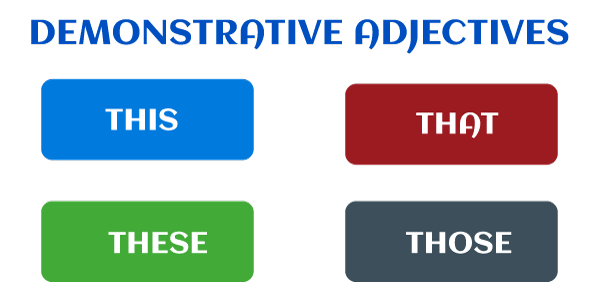
Demonstrative adjectives enable you to distinguish between the two amicable felines due to its physical placements in this scenario. 2. The second most common usage of demonstrative adjectives is to allude to specific points in time. As in the earlier examples, this and these are used to refer to present, recent, or soon-to-be-occurring events in time, whereas that and those are often used to allude to moments that happened or will occur in the future. As an example:
Common Demonstrative AdjectivesThis, that, these, and those are the most popular demonstrative adjectives. In a statement, the demonstrative adjective comes directly just before the noun or pronoun and tells readers which one it is explicitly modifying. 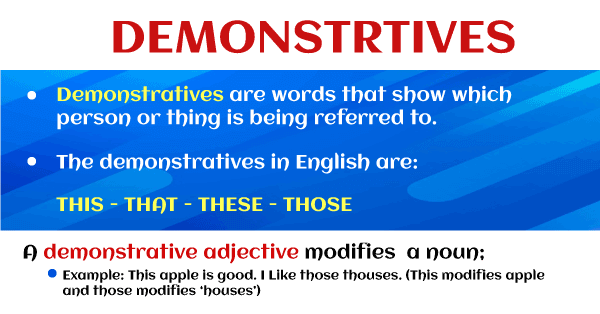
You select the appropriate demonstrative pronoun by specifying its distance (near or far from you) and its number (singular or plural). The following are the main singular variants of demonstrative adjectives:
The following are the main plural forms of demonstrative adjectives:
In What Parts of A Sentence Should Demonstrative Adjectives Be Used?Demonstrative adjectives are placed before the nouns and pronouns that they change. These adjectives, in particular, are always placed first in adjective order:
Can Numbers Be Used to Demonstrate Adjectives?Ordinal numbers (like third, fourth, or fifth) can be demonstrative adjectives. Like some other demonstrative adjectives, they show which nouns you are to mentioning to
Cardinal numerals, or regular numerals used mostly for counting, are not demonstrative adjectives. They are descriptive adjectives when they indicate the quantity of an object ("two cats" or "sixteen lamps"). Determiners And Demonstrative AdjectivesAdjectives, unlike nouns and verbs, have a more unclear classification system. Several style guides and grammar resources, for example, regard demonstrative adjectives to be a category of words called determiners, wherein instance, they may be referred to as demonstrative determiners or simply demonstratives. The demonstrative adjectives that, this, those, and these, unlike many other adjectives, can be utilized as demonstrative pronouns, as in example;.
Furthermore, demonstrative adjectives cannot be combined to make superlative or comparative adjectives. Something could be larger (the comparative adjective of large) than some other thing, but not "that-er" or "these-er" than some other thing. Although these characteristics might justify defining demonstrative adjectives as a distinctive part of speech, still the terms this, that, these, and those are often regarded as adjectives whenever employed as demonstrative adjectives. However, not every guideline will follow this approach, so don't be shocked if the terms this, that, these, and those are alluded to as determiners even though employed as adjectives. Demonstrative Adjective Rules and Best Practices1. Remember that demonstrative adjectives are adjectives, which implies these can only be utilized to change nouns and pronouns. Whenever they do, they are used prior to the nouns they are modifying, and they are mostly placed first in adjective order: ❌ Incorrect: I wish to cuddle an adorable kitten that. ❌ Incorrect: I wish to cuddle adorable that kitten ✅ Correct: I would like to cuddle that adorable kitten. 2. This and that are demonstrative adjectives that are employed with singular nouns and pronouns. These and those are demonstrative adjectives that are employed with plural nouns and pronouns. To steer clear of grammatical mistakes, determine if the noun or pronoun is singular or plural so that you can utilize the appropriate adjectives.
3. Finally, the terms this, that, these, and those aren't just utilized as adjectives. All of these terms can be employed as demonstrative pronouns, with the exception of the term that can even be employed as an adverb or a conjunction. None of the preceding criteria or limits apply if these terms are not employed as an adjective. As an example:
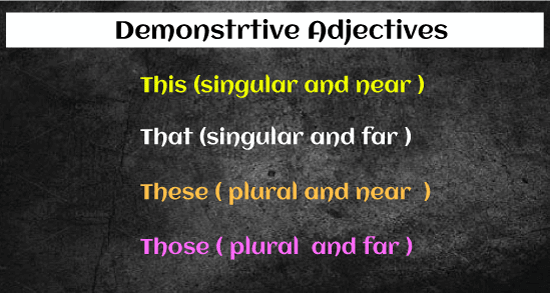
Examples of Demonstrative Adjectives in A StatementThe demonstrative adjective is highlighted in each of the following statements. Example 1 This timepiece appears to be very pricey. (The demonstrative adjective shows that the timepiece is close by.) You may be holding it in your hand, or it may be on display near you.) Example 2 Susan's engagement was spectacular, and she will never forget that event. (A demonstrative adjective indicating that the event or the day occurred in the past.) Example 3 I can't quite decide whether to taste this dessert or that one. (The demonstrative adjective this changes the noun dessert to express proximity.) The demonstrative adjective that changes the pronoun one to show that the object is placed in a different location, further away. Some more examples;
Demonstrative Adjectives vs. Demonstrative PronounsDemonstrative pronouns and adjectives both include this, that, these, and those. What is the distinction amongst both of these, what makes them different? It all depends on how you are using them and placing in the sentences. Demonstrative adjectives appear prior to the noun they explain, whereas demonstrative pronouns take the place of the nouns they symbolize. Demonstrative adjective - Pass me that pen, please. Demonstrative pronoun - Pass me that, please. Demonstrative adjective - Have you seen this serial? Demonstrative pronoun - Do you desire to view this? Demonstrative adjective -Watch those ducks! Demonstrative pronouns- See those! Demonstrative adjective -These crisps are just too peppery for me. Demonstrative pronoun - These are too peppery for us. 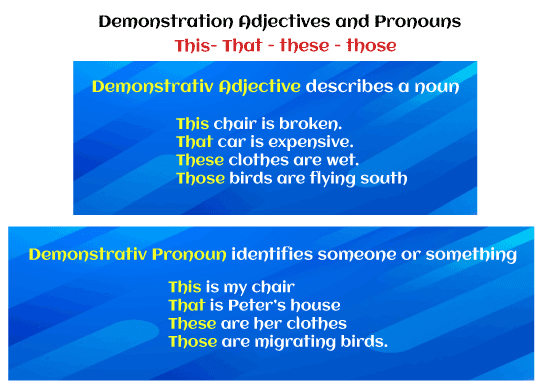
When using demonstrative pronouns, the noun you're substituting is either evident or has already been stated. You're employing a demonstrative adjective if the noun is still there.
Next TopicPossessive Adjectives
|
 For Videos Join Our Youtube Channel: Join Now
For Videos Join Our Youtube Channel: Join Now
Feedback
- Send your Feedback to [email protected]
Help Others, Please Share









